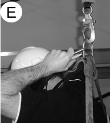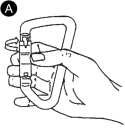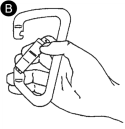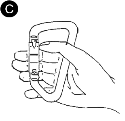Instructions For Use
Carabiner Operation
Hitch Loop Operation - QR Code links to Hitch Loop Operation Video

|
|
1.
|
Attach one Safety Step Pouch or one on each side, at the webs that cross at the hip level. |
|
2.
|
To attach the hitch loop, feed the pouch through the loop around the webs that cross at hip level. |
|
3.
|
Pull tight to secure the hitch loop on the webs that cross at hip level. |
|
Suspension Trauma Safety Step - Hitch Loop Operation Video
NOTE: MSA recommends one safety step on each side of the harness while using the hitch loop attached at the webs that cross at hip level.
How to Deploy Safety Step with Carabiner
Follow these steps as soon as practical after a fall:

|

|
|
1.
|
Open the carrying bag and deploy the Safety Step to its full length. Take care to always keep hold
of the Safety Step with two hands to prevent dropping it (Fig D). |
|
2.
|
Connect the carabiner to the harness back D-ring or to the snaphook attached
to the lanyard (Fig E). |
|
a.
|
After a fall, the D-ring will be located approximately at the
level of the head, within easy reach. |
|
b.
|
Be sure to hold the Safety Step with
both hands while connecting the carabiner until you are sure the carabiner
is closed and locked onto the D-ring. |
NOTE: The safety step should drape over the front of the shoulder.
|
Safety Step Use

|

|

|
|
1.
|
Place one foot in a low-hanging loop, holding the Safety Step strap steady
with the hands in front of the body (Fig F). |
|
2.
|
Place the other foot in the loop next to the first (Fig G). |
NOTE: The feet should be positioned on either side of the central strap, low enough to straighten the legs as far as practical.
|
3.
|
With both feet in adjacent loops of the Safety Step, flex, or “pump” the leg
muscles frequently while suspended in the harness (Fig H). |
NOTE: Pumping the large muscles of the leg causes blood to circulate and reduces the potential for suspension trauma.
|
WARNING!
|
•
|
Do not unfasten the leg or shoulder buckles of the harness while suspended. |
|
•
|
Monitor the suspended worker for signs and symptoms of suspension trauma before and after rescue. Ensure that the worker is evaluated by a healthcare professional. |
Failure to follow these warnings can result in serious personal injury or death.








